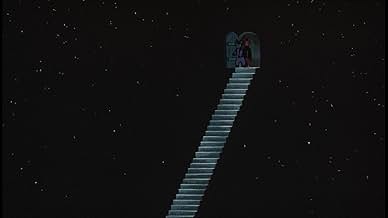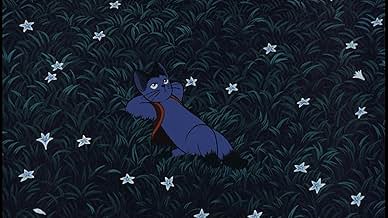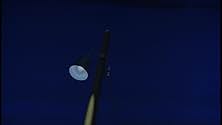IMDb रेटिंग
7.0/10
2.6 हज़ार
आपकी रेटिंग
अपनी भाषा में प्लॉट जोड़ेंTwo kittens go on a metaphysical journey on a magical railroad train.Two kittens go on a metaphysical journey on a magical railroad train.Two kittens go on a metaphysical journey on a magical railroad train.
- निर्देशक
- लेखक
- स्टार
- पुरस्कार
- कुल 1 जीत
Mayumi Tanaka
- Giovanni
- (वॉइस)
Chika Sakamoto
- Campanella
- (वॉइस)
Junko Hori
- Zanelli
- (वॉइस)
Kaori Nakahara
- Kaoru
- (वॉइस)
Reiko Niimura
- Old Woman
- (वॉइस)
Chikao Ôtsuka
- Birdcatcher
- (वॉइस)
- (as Chikao Ohtsuka)
Seiji Kurasaki
- Milkman
- (वॉइस)
Ryûnosuke Kaneda
- Teacher
- (वॉइस)
- …
Amy Birnbaum
- Tadashi
- (English version)
- (वॉइस)
फ़ीचर्ड समीक्षाएं
The first time I watched this movie I had to see it in two parts because my friend got sick of it after the first half. This movie is definitely not for everyone. The pacing is extremely slow and thoughtful. If your not the sort of person who spends time contemplating the mysteries of life, you will not enjoy this movie. If you watch this movie, don't watch it by yourself. Find a friend who you think might enjoy it, and set aside a quite relaxed evening to watch it. You will want someone to talk it over with afterwards.
One thing that must be noted is the character design. You may be initially turned off by the extremely cute, childish-looking characters. It doesn't take long to realize that the film is much darker and deeper than it seems at first.
Something to think about when viewing this film: It's interesting to see the strong use of Christian imagery in this film. I can't help but feel that as a westerner I'm getting a different reaction than the primarily Buddhist original audience and perhaps losing a bit of the mysticism.
I would suggest this film to anyone who enjoys spending a quiet evening lost in thought.
One thing that must be noted is the character design. You may be initially turned off by the extremely cute, childish-looking characters. It doesn't take long to realize that the film is much darker and deeper than it seems at first.
Something to think about when viewing this film: It's interesting to see the strong use of Christian imagery in this film. I can't help but feel that as a westerner I'm getting a different reaction than the primarily Buddhist original audience and perhaps losing a bit of the mysticism.
I would suggest this film to anyone who enjoys spending a quiet evening lost in thought.
Kenji Miyazawa intended "Ginga tetsudo no yoru" as a book for children. But in it are truths that everyone big and small look to find. No one is comfortable with death. Everyone searches for answers. As I read the book before seeing the movie, I was amazed to see how accurately and wonderfully the director and animators were able to capture the feeling of this fantasy. It may be too arty for some, but I feel that more often than not, viewers will come away with a deeper sense of what death can do for life and what life can mean if given a chance.
As for the cat characters, this seems to be a consistent image that surrounds Miyazawa. Some of the stories he wrote were populated by cats that would take human roles. Interestingly enough, in Kenji Miyazawa's biographical anime (Shoji Kawamori's Spring and Chaos) Miyazawa is portrayed as a cat. Maybe the cats exist to shield children from the pain that these harsh truths might bring. But not shield too much
Sometimes it is easy to look at a work like Night on the Galactic Railroad and say, this is just a fantasy. Perhaps Miyazawa wanted us to think that, maybe at first anyhow. But the true beauty behind this animation is that by creating a fantasy world so wild and vibrant, it forces us to see who and what we really are.
As for the cat characters, this seems to be a consistent image that surrounds Miyazawa. Some of the stories he wrote were populated by cats that would take human roles. Interestingly enough, in Kenji Miyazawa's biographical anime (Shoji Kawamori's Spring and Chaos) Miyazawa is portrayed as a cat. Maybe the cats exist to shield children from the pain that these harsh truths might bring. But not shield too much
Sometimes it is easy to look at a work like Night on the Galactic Railroad and say, this is just a fantasy. Perhaps Miyazawa wanted us to think that, maybe at first anyhow. But the true beauty behind this animation is that by creating a fantasy world so wild and vibrant, it forces us to see who and what we really are.
This film is up there with all of Miyazaki's works, including "Spirited Away," "Princess Mononoke," and "My Neighbour Totoro."
It has a very surreal quality and a deceptive cuteness to it, which may trick you into thinking it trite or superficial. However, like some of the best Anime out there, "cute" can leave you open to some horrifying consequences. Obviously it's not as heavy as "Grave of the Fireflies" or as light hearted and uplifting as "Totoro", but this film lies somewhere in between. I haven't read the book, but I'll bet it's similar in theme and scope to "Le Petit Prince" by Antoine de Saint-Exupéry.
I'm certainly not a Christian, and often tire easily when confronted by blatant Christian imagery in film, literature, and music. However, this film requires a degree of spirituality to get its point across, and the Christian images present, while overpowering at times, represent a nebulous kind of spirituality -- as if it's saying "there is a force out there which helps determine our fates, but I can't define what it is."
For example, the film takes place in some alternate European world (most likely Italy) and the characters have Italian names. But they're anthropomorphic cats and don't appear to practice any kind of Christianity (they celebrate moon festivals, and sail lantern boats in the river). However, they later meet up with human children on the train, and listen to Christian hymns on the wireless ("Nearer my God to Thee"). They pass several different layers of Heaven, and Giovani, the main character, has a special ticket that allows him passage to "the one True Heaven".
The film, like the train, takes its time to get where it's going, and some powerful messages come across to the viewer. Unlike many Anime and Western films, this one does not end with a happy and neatly tied-up ending, nor does it take pains to explain the things that go on inside the train. It leaves that to the viewer. This is what makes good art films. This is what makes a film worthwhile.
It has a very surreal quality and a deceptive cuteness to it, which may trick you into thinking it trite or superficial. However, like some of the best Anime out there, "cute" can leave you open to some horrifying consequences. Obviously it's not as heavy as "Grave of the Fireflies" or as light hearted and uplifting as "Totoro", but this film lies somewhere in between. I haven't read the book, but I'll bet it's similar in theme and scope to "Le Petit Prince" by Antoine de Saint-Exupéry.
I'm certainly not a Christian, and often tire easily when confronted by blatant Christian imagery in film, literature, and music. However, this film requires a degree of spirituality to get its point across, and the Christian images present, while overpowering at times, represent a nebulous kind of spirituality -- as if it's saying "there is a force out there which helps determine our fates, but I can't define what it is."
For example, the film takes place in some alternate European world (most likely Italy) and the characters have Italian names. But they're anthropomorphic cats and don't appear to practice any kind of Christianity (they celebrate moon festivals, and sail lantern boats in the river). However, they later meet up with human children on the train, and listen to Christian hymns on the wireless ("Nearer my God to Thee"). They pass several different layers of Heaven, and Giovani, the main character, has a special ticket that allows him passage to "the one True Heaven".
The film, like the train, takes its time to get where it's going, and some powerful messages come across to the viewer. Unlike many Anime and Western films, this one does not end with a happy and neatly tied-up ending, nor does it take pains to explain the things that go on inside the train. It leaves that to the viewer. This is what makes good art films. This is what makes a film worthwhile.
Superior to almost every toe-curling art-house flick that touches on similar territory Night on the Galactic Railroad says more and presents itself better than one would expect coming from a mere animated movie. Indeed if this was re-shot in live action, maybe in black and white and dubbed into French it would become a canonical post new-wave classic: to be fawned over by leagues of pea-brained cineastes. However it remains a little known and rarely talked about anime that has been seen by more fans of Galaxy Express 999 than by fans of Alan Resnais. Based upon the short children's work of the same name by Kenji Miyazawa the tale is ostensibly of a young cats (Giovanni) coming to terms with death by means of a surrealist adventure along the titular Galactic Railroad. The film contains a sequence of superbly realised vignettes that gradually paint the picture of Giovanni's life at home; his ill mother and itinerant father, bullying classmates and later the fantastical sights and stations he encounters on his one way ticket to the edge of the universe. The train he boards carries with it passengers of many creeds and persuasions: some disembark at the Pliocene Coast to further the cause of science others exit only to blithely tramp towards an afterlife of either Pagan, Christian or Buddhist contrivance . . . but young Giovanni stays on until the end. The less alert may mistake this film for some sort of religious allegory but it is nothing of the sort: Giovanni's revelation at the end seems more a triumph of moral philosophy. All text in the movie is written in Esperanto and the locations on Earth are reminiscent of small town medieval Europe. Beautifully scripted, animated and immaculately directed by Sugii Gisaburo, Night on the Galactic Railroad is one of the unsung masterpieces of cinema.
Night on the Galactic Railroad isn't your traditional family film. It deals with some incredibly deep themes, as well as having a slow meditative pace. We follow a young cat (changed from human in the original book) called Giovanni. Giovanni has no time for himself. His father is away, his mother is sick, and when he isn't at school he has to work. One evening the family's delivery of milk never comes, so Giovanni goes to get it. He rests on top of a hill before being confronted by a train. He gets on and finds his friend Campenella. From there the duo encounter a number of passengers each with a strange story to tell. This film is certainly all about the metaphysical. Each story strengthens the themes of religion and sacrifice. It gets highly emotional at times. The imagery is often surreal but always memorable. The animation is calm in both colours and movement. This film is presented in chapters, which I think may be a better way to digest it. It's something no country but Japan would try, and the ending is so powerful it really does make the journey worth it. Mature and thoughtful, if sometimes a little slow.
क्या आपको पता है
- ट्रिवियाThe language depicted in texts/captions throughout the film is Esperanto, an artificial universal language that was created to be spoken internationally, and in which Kenji Miyazawa was deeply interested. The film even holds a title in Esperanto ("Nokto de la Galaksia Fervojo").
- कनेक्शनReferenced in Îhatôbu gensô: KENjI no haru (1996)
टॉप पसंद
रेटिंग देने के लिए साइन-इन करें और वैयक्तिकृत सुझावों के लिए वॉचलिस्ट करें
- How long is Kenji Miyazawa's Night on the Galactic Railroad?Alexa द्वारा संचालित
विवरण
- रिलीज़ की तारीख़
- कंट्री ऑफ़ ओरिजिन
- भाषाएं
- इस रूप में भी जाना जाता है
- Kenji Miyazawa's Night on the Galactic Railroad
- उत्पादन कंपनियां
- IMDbPro पर और कंपनी क्रेडिट देखें
इस पेज में योगदान दें
किसी बदलाव का सुझाव दें या अनुपलब्ध कॉन्टेंट जोड़ें



























